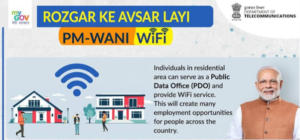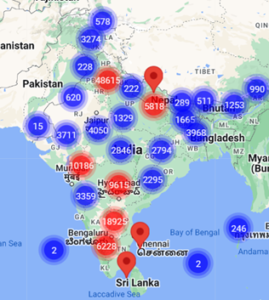A win-win for all.
Like UPI, PM-WANI has potential to transform India’s digital public infrastructure
Relevance
- GS Paper 2 Welfare schemes for vulnerable sections of the population by the Centre and States and the performance of these schemes; mechanisms, laws, institutions and Bodies constituted for the protection and betterment of these vulnerable sections.
- Government policies and interventions for development in various sectors and issues arising out of their design and implementation.
- Tags: #PMwani #wifi #Jobgrowth #currentaffairs #upsc.
Why in the News?
- The Digital India Programme set out with three primary vision areas: Connectivity, software and services on demand, and digital empowerment of citizens. In the modern age, ubiquitous digital connectivity is a fundamental necessity.
- Over the past seven years, multiple factors, such as the mobile telephony boom, 4G coverage expansion, tariff reductions, and increased smartphone adoption, have dramatically reshaped the connectivity landscape in India.
- Complementary policies like Net Neutrality and the development of Digital Public Infrastructure (DPI), notably Digital ID and UPI, have further fueled the Digital India vision, resulting in a substantial surge in digital transactions.
The Data Dilemma
- However, this remarkable growth has also led to a substantial surge in data demand. India’s per capita data consumption has reached an astounding 19.5 GB per month, and the total data volume transported by mobile networks surpasses that of the mobile networks of both the US and China combined.
- This highlights a considerable gap between demand and affordable supply, particularly affecting underprivileged households and rural areas.
The Concept of Interoperable Public WiFi
- In 2017, the Telecom Regulatory Authority of India (TRAI) proposed the creation of interoperable public WiFi hotspots, akin to the PCOs (Public Call Offices) of the past.
- This envisioned the establishment of millions of interoperable Wi-Fi hotspots called Public Data Offices (PDOs) to serve as a shared infrastructure for last-mile broadband distribution in affordable packages costing Rs 5-10.
- This concept was successfully piloted and presented to the Department of Telecom (DOT) as the Wi-Fi Access Network Interface (WANI).
- This framework presented an attractive business opportunity for aggregators by allowing the unbundling of internet distribution at the last mile, eliminating the need for additional licensing fees. Importantly, it laid a robust foundation for delivering affordable internet access to a significant portion of the population.
Opposition
- Unsurprisingly, there were objections to this idea, with the Cellular Operators Association of India (COAI) asserting that there was no need for PM-WANI as they would create a million hotspots within a year. Regrettably, little progress was made.
- Now, the operators, known as Public Data Office Aggregators (PDOAs), have resumed their work.
- Critics who argue against PM-WANI claim that cheap data and widespread 4G connectivity render Wi-Fi hotspots unnecessary.
- This viewpoint, however, oversimplifies the situation. The increased demand for video and a plethora of applications still makes it unaffordable for many low-income families to access the internet.
Transformational Approval
- It took three years for the DOT to approach the Union cabinet, and in December 2020, PM-WANI received its transformative approval.
- The framework eliminated the requirement for licenses or permits to begin operations, leading to the resurgence of startups that had participated in the initial pilot. However, the onset of the COVID-19 pandemic briefly interrupted progress.
Promising Progress
- Despite initial challenges, there has been promising progress, albeit on a small scale and in isolated pockets of the country. In the past year alone, over 1.5 lakh Wi-Fi hotspots have been installed by PDOAs, serving over a million people who enjoy unlimited internet access for just Rs 5-10 per day.
Unleashing Local Nano Entrepreneurs
- PM-WANI creates a win-win situation for all stakeholders involved and fosters the growth of local nano-entrepreneurs.
- These last-mile providers, often found in small shops, local establishments, and even households, can supplement their monthly income while promoting internet usage.
The Path Forward for PM-WANI
Overcoming Underutilization
- While significant infrastructure exists, it remains underutilized, and many major Internet Service Providers (ISPs) hesitate to enter underserved areas. This presents a golden opportunity for the PM-WANI framework to flourish.
- It also benefits ISPs and Telcos, as they can sell more bandwidth by enabling their end customers to become retailers.
The Need for Promotion
- PM-WANI deserves promotion and support from all stakeholders. Its uniquely Indian approach of interoperability, openness, and scalability holds the potential to accelerate like UPI and other Digital Public Infrastructures in our country.
- Much like UPI revolutionized the financial sector in India, PM-WANI is poised to become a distinctive Digital Public Infrastructure that transforms connectivity.
In conclusion, PM-WANI, with its potential to bridge the digital divide, accelerate high-speed unlimited internet penetration, and empower communities nationwide, presents a win-win situation for all. This framework embodies the spirit of Digital India, and its success would significantly contribute to the nation’s digital growth and empowerment.
| Prime Minister’s Wi-Fi Access Network Interface (PM-WANI)
· The Department of Telecom (DoT), a branch of the Ministry of Communications, serves as the pivotal agency responsible for expanding broadband access through Public Wi-Fi networks, operating within the PM-WANI framework. · PM-WANI, initially proposed by the Telecom Regulatory Authority of India (TRAI) in 2017. · It aims to deliver public Wi-Fi services through a network of Public Data Offices (PDOs) spanning the entire nation, reminiscent of the transformative role that Public Call Offices (PCOs) played in the proliferation of telephones across India. · Public Data Office Aggregators (PDOAs) will be instrumental in setting up the Public Wi-Fi Networks, fostering accessibility and affordability. · Notably, the establishment of Public Data Offices (PDOs) will not necessitate licenses, registrations, or any associated fees. Key Features of the PM-WANI Ecosystem · The PM-WANI ecosystem will function through distinct entities, including Public Data Offices (PDOs), Public Data Office Aggregators (PDOAs), App Providers, and a Central Registry. · PDOs will have the flexibility to either provide internet services independently or lease from other Internet Service Providers (ISPs), thereby promoting competition and diversity. · The establishment of a Central Registry, overseen by the Centre for Development of Telematics (C-DoT), will compile comprehensive information on app providers, PDOAs, and PDOs, streamlining operations and ensuring transparency. · To enhance user experience, an app developer will create a user-friendly platform for user registration and the discovery of Wani-compliant Wi-Fi hotspots in specific areas, conveniently displaying them within the app interface. |
Sources: Indian Express.
Mains Question
“Critically analyze the impact of PM-WANI on India’s digital public infrastructure and its comparison with similar initiatives like UPI in revolutionizing the digital space.” 250words.





